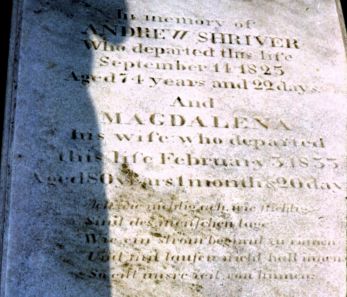THE SHRIVER FAMILY GREEN BOOK.
PART SECOND. NARRATIVES AND RECORDS TO THE PRESENT TIME. 1888.
(Page numbers from 1888 Green Book in [square brackets].)
![]()
The Conewago Settlement in Early and Later Times
Christ Church and Burial Ground | Conclusion
[154]
In addition to the history — Chapter I — of the Conewago settlement, by the Shrivers and others, the following facts and incidents, gleaned from a “Historical sketch of Christ Church,“ by the Rev. John Ault (1875), pastor of the church, will be found of interest. The region known in early times as the “Conewago Settlement” is described as “dangerous ground.” The land was claimed by both Maryland and Pennsylvania, and much turbulence prevailed for many years; “blood was spilt, and a number of lives were lost.” Indians, also, invaded the territory, and “sometimes committed barbarous depredations upon the white settlers.”
The first settlers in what was then Lancaster county were, principally, Scotch-Irish. Some of them came prior to 1740, but many more between 1740 and 1750. They did not settle in the low lands, but took to the Highlands where they could enjoy the invigorating atmosphere, and obtain bountiful supplies of refreshing spring water; reminding them of their native Highlands in Scotland. These people were, generally, Presbyterians. Prior to 1747 some Germans had arrived, and, in that year, large numbers came, the majority (as appears from the Christ Church records) being from the Palatinate, principally of the Reformed and Lutheran churches.
Unlike the Scotch-Irish, their native sagacity, thrift and shrewdness led them to select the rich limestone lands of the valleys. Among these early German immigrants, forming settlements within the present limits of York and Adams counties, Pa., are found the still familiar names of Hoke, Wolf, Schwob (Swope?), Spengler (Spangler), Moyer (Myer), Bishop, Schwarti (or Black); Schultz, [155] Wielchans (Welsh?), Kitzmiller, Schreiber (Shriver), Forhney (Forney), Kuhnz (Koontz), Young, Dutro, Klein (Little), Miller, Felty, Will, Maus, Sell, Sheely, etc.
The old Christ Reformed Church, Conewago, was organized by the Rev. Michael Schlatter, A. D. 1747. He was, at the time, stationed at Philadelphia, and preached there and at Germantown, occasionally journeying on horseback through the inland country for hundreds of miles; preaching, and organizing churches. On one of these occasions (1747), he visited the Conewago settlement, preached, and organized the church there. Eighty members united in the first communion service, which was held at the time, and twenty-one children were baptized. Afterward, (1750), the people secured land for a church and burial ground, and erected a small, log church edifice. This edifice was, subsequently, enlarged so as to give it the form of a cross, whence the name “Kreuz Kirche” (Church of the Cross) originated.
In 1798 the log church was replaced by a substantial, and commodious brick one, which, as lately remodeled, continues in the service of the congregation. At the time — 1798 — Andrew Shriver, Jr., and Jacob Parr, were the elders of the church. The building committee was composed of Andrew Shriver, Jacob Parr, Conrad Duttera, Ludwig Maus and Jacob Will. John Dysert was Secretary of the Board of Trustees. Subscriptions toward the new church building ranged from twenty-five cents to a thousand dollars. A debt, however, remained on the edifice, and Andrew Sbriver was commissioned to visit Baltimore in the interest of its liquidation; but he received “only a few dollars.” It was finally paid by the members. Andrew Shriver, it is stated, boarded, gratuitously, the greater part of the workmen employed upon the church building. The Deacons of the church (1784), were George Kuhns (Koontz), Jacob Will, Jacob Sheely, Jacob Wintrode and John Kitzmiller. In 1794 George Maus was Treasurer. Henry and Samuel Shriver, sons of Andrew Shriver, Jr., were subsequently Treasurers, Samuel serving for a number of years. These facts are of value as indicating the influence exerted by the Shriver family of Conewago, together with their connections, [156] in furthering the moral and religious interests of the community.
The burial ground at Christ Church, Conewago, is a place of much interest to the descendants of these first settlers. Most of the fathers and mothers of these past generations were gathered to “mother earth” within its hallowed precincts. The tomb-stones of Andrew Shriver, Senior and Junior, and their wives, have been well preserved, and bear the following inscriptions:
“Hir ruhet Andreas Schreiber, geboren den 6ten Dezember 1712, gestorben den 12ten August Anno 1797″
[Note: Genealogical Tables, Record I. indicates birth month as September.]
“Hir ruhet Anna Maria Schreiber, geboren den __ September 1710, gestorben den 8ten Mai Anno 1801.”
“In memory of Andrew Shriver, who departed this life September 14, 1823, aged 74 years and 22 days; and
“Magdalena, his wife, who departed this life February 3, 1833, aged 80 years, 1 month and 20 days.”
“Ach wie nichtig, ach wie fluchtig,
“Sind des Menschen Tage;
“Wie ein Strom beginnt zu rinnen,
“Und mit Laufen nicht halt innen.
“So eilt unsre Zeit von hinnen.”
[Translation]
“Ah, how trifling; ah, how fleeting
“Are the days of man;
“As a stream begins to flow,
“And in its flow ceases not,
“So speeds our time away.”
The tombstones marking the graves of our ancestors are destined to decay; the names and dates will be obliterated by the finger of time. Still, it is possible, and proper, to honor their memories by emulating their virtues; as for their names, though liable to be forgotten by men, it is written, “The righteous shall be in everlasting remembrance.”
We have thus reached the conclusion of this brief, and, in many respects, imperfect history. Those members of the family who have kindly shared in these “labors of love” commemorative of our ancestry, are entitled to, and should receive, the due measure of thanks and obligations.
THE END


